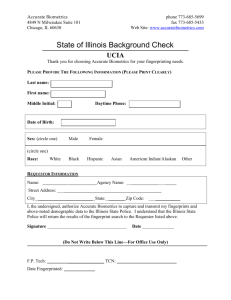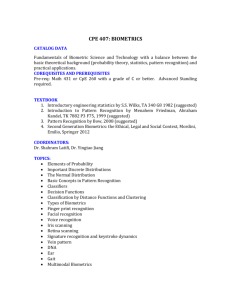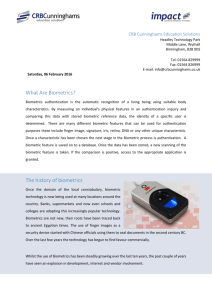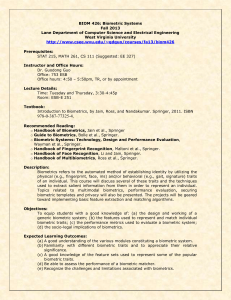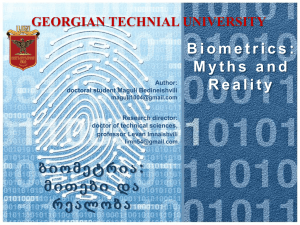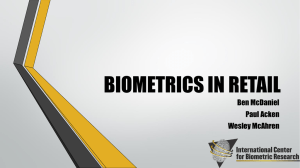Upgrade Master Template copy
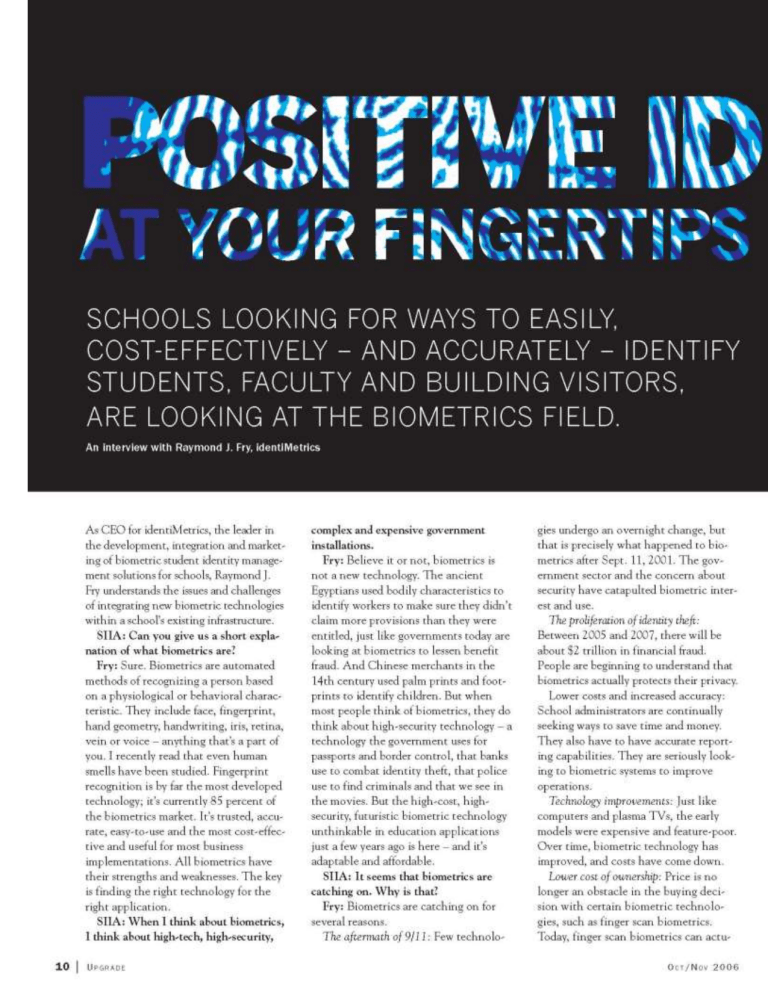
ally be priced competitively with barcode readers, swipe card readers and PIN pads from a total cost-of-ownership viewpoint.
Consumer awareness: Recently, we have seen biometrics introduced and advertised in a variety of areas in the consumer marketplace. Laptop computers, grocery stores and automobiles, for example, are using a biometric finger scanner to identify people. We find that the more familiar people are becoming with biometrics, the more they feel comfortable and like the convenience of just having a finger for identification. In fact, a growing number of Americans believe finger scanning is a more secure form of identity gers to create templates. Flat images reveal the center of the finger and require only a minimum of unique identifying points in order to make a match. The purpose is to identify a person already enrolled in the software. Fingerprints can never be re-created. We have found that
100 percent of our customers that have used our software in a pilot setting buy it.
SIIA: What are schools using now for identification?
Fry: Many functions in a school environment require identification. The most common kinds of identification currently in use are smart, swipe, barcode or picture ID cards; PINs; and, of course, visual identification. Each of these methods creates its own issues and keeping very accurate. Finger scanning can be used to identify people coming into the school on a regular basis, such as substitute teachers, contractors and parents, so the administrators know who is in their school at all times and when they left. This has proved to be an invaluable tool for a school, especially when there is an incident that requires investigation.
Biometrics can be used to identify students as well. There are several areas where a school can use biometrics to help improve operations. The cafeteria is usually the first area in the school to embrace biometrics. With up to 80 percent of students forgetting or loosing their cards on a daily basis or forgetting than passports, credit cards, photo IDs, birth certificates and signatures combined. And when biometrics are introduced on cell phones in the United States in the next year and a half (they’re already in Japan), we expect that the acceptance of biometrics will explode.
Experts predict a 29 percent annual growth in a worldwide biometrics market that’s expected to reach $3.4 billion in
2007.
SIIA: What about privacy issues?
Fry: Biometric technologies don’t conjure up the Orwellian fears they used to.
Of course, some people still grumble at the mention of systems that scan fingerprints because of misunderstood privacy fears, but overall the acceptance of biometrics has risen substantially over the past few years. In fact, people are now realizing that biometrics actually protect their privacy and that in many biometric applications, including the one identiMetrics employs, their fingerprints are not stored anywhere and their fingerprints can never be re-created from the digital template. Minutiae-based systems, like ours, use flat images of only two fin- delays and is also a drain on time and resources.
Cards are regularly forgotten, lost, mutilated and shared. PINs are easily forgotten, especially with young children, swapped or stolen. And visual identification is a poor solution especially with today’s considerable security concerns and reporting issues. By using biometrics for identification, the problems and costs associated with the current methods can be avoided, and new standards of accountability can be put into place.
SIIA: Why would a school use biometrics?
Fry: Quite simply, to save time and money and improve the accuracy of reporting. Biometric technology can provide benefits in terms of convenience, safety and security. There are two areas of identification schools have to manage: students and employees. Biometrics are beginning to be used in both of these areas.
In some schools, teachers, staff and employees are using finger scanning for time and attendance, making record or sharing their PINs, lines are slowed and mistakes are made. Biometrics will be used in vending machines in the near future to ensure positive identification of children eating free or reduced lunch.
Consider using biometrics for attendance in order to eliminate “buddy punching” and for providing irrefutable proof of attendance for record-keeping purposes.
Biometrics can help cut down on class cutting when attendance is taken on a period-by-period basis; this is a headache for every school administrator. Biometrics can be used in the library to check out books, eliminating the need to swipe a card or punch in a PIN and protecting the school’s assets. Biometrics can be used in the nurse’s office to make sure students are receiving the correct medication, a liability in every school environment especially with the amount of medication being dispensed on a daily basis. And using a biometric identification system that is a platform will ensure that as your needs for biometric identification grow within your school and school district, your system will be able to scale.
SIIA: What would you recommend as a practical way to implement biometrics?
Fry: Start by making small improvements. You want to improve productivity, record-keeping and of, course, safety.
Take baby steps. Identify and assess your
“pain.” Where in your school could you use finger scanning instead of cards and
PINs save you time and money? Is it in the cafeteria? At the front door? You people who will be involved. This is usually the weak link in implementing any new technology, and implementing biometrics is no different. Train, train and train some more. We have found that once biometrics is being used successfully in one part of the school, the idea migrates and is number of students increases in a networked environment. A more robust biometric technology might cost a bit more but will be worth it in the long run.
Make sure it can integrate with the software applications you already have in place, if you don’t want to replace them.
Many biometric technologies will only work with a specific application. Other biometric technologies can easily be integrated into applications you already have that are working just fine.
Make sure it works. Some people’s fingers, especially young children’s, are just hard to read. Most biometric companies have only focused on adult fingers for employing biometrics in mass implementations. Make sure any product you about biometrics. identiMetrics has published a “Guide to Implementing
Biometrics,” which includes, for instance, sample letters to parents, biometric FAQs, best practices and other important information to make the whole process run smoothly and easily.
Cost-effective biometric technology is here today with practical uses for schools.
It’s a perfect solution for schools dissatisfied with the current student identification systems. Biometrics, and in particular finger scanning systems, provide irrefutable proof of identification. Unlike the complicated and expensive government systems in the past, biometric finger scanning systems can be simple, cost-effective and technology friendly. embraced in other areas as well.
SIIA: What should a school think about when choosing the right biometric solution?
Fry: Great question since this can be a daunting task. It is really important to not be short-sighted here.
Choose a biometric identification platform that can eventually be used throughout your entire school. This means students should be enrolled only once to be identified in a variety of areas in the school – the cafeteria, the front door or classroom for attendance, the nurse’s office, the library and the office for absence information entry.
Make sure it can scale if needed. Some biometric technologies work great with
10 students or fewer in a stand-alone environment but fail miserably as the purchase can read the fingers of young children – a must in any school setting.
Ask about performance accuracy. There are basically four metrics: false acceptance, false rejection, failure to enroll and failure to acquire rates. In particular, false acceptance rates are what you should be most concerned about. That means I place my finger on the scanner, and your name comes up.
Compare but not just on price. Check up on customer support and rollout experience. Once again, make sure the technology works in a practical setting and not just in a vendor lab.
Communicate, communicate and communicate. Make sure everyone – parents, teachers, students, administrators, the school board and the media – have up-to-date, accurate information
12 |
U
PGRADE
O
CT
/N
OV
2006
Raymond J. Fry is president and CEO and chairman of the board for identiMetrics.
He brings a wealth of experience to identiMetrics, having served as an executive professional throughout his career. He was formerly the principal and senior administrator for a large school in the Chicago area. identiMetrics Inc., an identity management company, is a leader in the development and marketing of biometric finger scan identification solutions. IdentiMetrics’ proprietary software, identiFi
TM
, is a biometric finger scanning ID platform that provides a cost-effective and accurate replacement for swipe-card readers, barcode readers and PIN pads. For more information, visit www.identimetrics.net.

